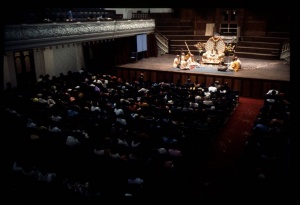CC Adi 17.124 (1975)

A.C. Bhaktivedanta Swami Prabhupada
Below is the 1996 edition text, ready to be substituted with the 1975 one using the compile form.
TEXT 124
- śuniyā ye kruddha haila sakala yavana
- kājī-pāśe āsi’ sabe kaila nivedana
SYNONYMS
śuniyā—by hearing; ye—that; kruddha—angry; haila—became; sakala—all; yavana—Muslims; kājī-pāśe—in the court of the Kazi, or magistrate; āsi’—coming; sabe—all; kaila—made; nivedana—petition.
TRANSLATION
Hearing the resounding vibration of the Hare Kṛṣṇa mantra, the local Muslims, greatly angry, submitted a complaint to the Kazi.
PURPORT
The phaujadarā, or city magistrate, was called the kājī (Kazi). The jamidāras (zamindars), or landholders (maṇḍalerās), levied taxes on the land, but keeping law and order and punishing criminals was the duty entrusted to the Kazi. Both the Kazi and the landholders were under the control of the governor of Bengal, which at that time was known as Subā-bāṅgālā. The districts of Nadia, Islāmpura and Bāgoyāna were all under the zamindar named Hari Hoḍa or his descendant known as Hoḍa Kṛṣṇadāsa. It is said that Chand Kazi was the spiritual master of Nawab Hussain Shah. According to one opinion his name was Maulānā Sirājuddina, and according to another his name was Habibara Rahamāna. Descendants of Chand Kazi are still living in the vicinity of Māyāpur. People still go to see the tomb of Chand Kazi, which is underneath a campaka tree and is known as Chand Kazi’s samādhi.